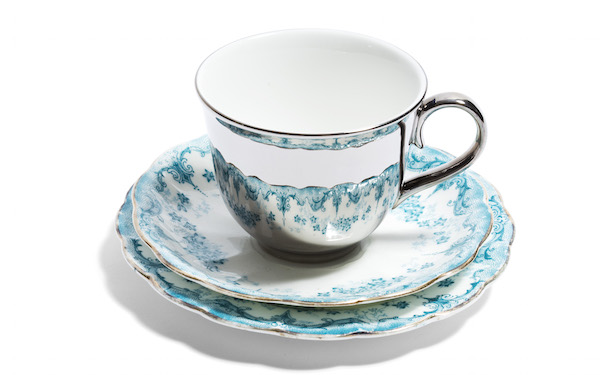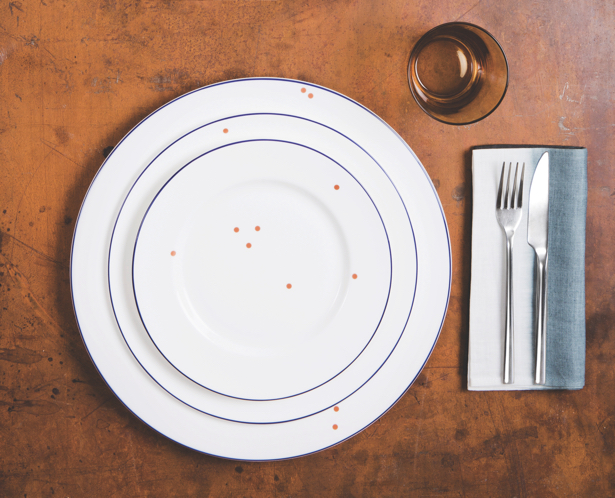Bone china porcelains are as quintessentially British as Marmite breakfast spread. At the end of the 18th century, Englishman Josiah Spode developed a technique to incorporate burned-up animal bones into porcelain, giving the resulting china its signature crisp white hue. More than two centuries later, another young Briton, 28–year-old Richard Brendon, has brought a thoroughly modern perspective to the craft without forgetting its roots. Brendon produces all his bone china in Stoke-on-Trent, England, where Spode himself was based. In 2010, while still an art student, the precocious talent’s final project caught the attention of trendy retailers in London and Paris, establishing him as an up-and-coming luxury designer. Brendon now oversees nine collections, including the recently launched cut crystal bar collection, his first non-ceramic endeavor, and a hand-painted, Art Deco-inspired line of tableware called Arc. He is currently working on a custom line of bone china dinnerware called Bespoke. Amidst all that activity, Brendon recently sat down with The Financialist to talk about his meteoric rise, his design ethos, and his dual role as entrepreneur and designer. TF: Where does your interest in ceramics come from? RB: I think I got the creative genes from my mom. She went to art school and then trained as a chef and worked as a caterer.
Topics:
Terrence Murray considers the following as important: bone china, ceramics, fine china, Living Well: Q&A, luxury, Reflect, richard brendon, stoke-on-trent
This could be interesting, too:
Bone china porcelains are as quintessentially British as Marmite breakfast spread. At the end of the 18th century, Englishman Josiah Spode developed a technique to incorporate burned-up animal bones into porcelain, giving the resulting china its signature crisp white hue. More than two centuries later, another young Briton, 28–year-old Richard Brendon, has brought a thoroughly modern perspective to the craft without forgetting its roots. Brendon produces all his bone china in Stoke-on-Trent, England, where Spode himself was based.
In 2010, while still an art student, the precocious talent’s final project caught the attention of trendy retailers in London and Paris, establishing him as an up-and-coming luxury designer. Brendon now oversees nine collections, including the recently launched cut crystal bar collection, his first non-ceramic endeavor, and a hand-painted, Art Deco-inspired line of tableware called Arc. He is currently working on a custom line of bone china dinnerware called Bespoke. Amidst all that activity, Brendon recently sat down with The Financialist to talk about his meteoric rise, his design ethos, and his dual role as entrepreneur and designer.
TF: Where does your interest in ceramics come from?
RB: I think I got the creative genes from my mom. She went to art school and then trained as a chef and worked as a caterer. She was forever creating things–menus for her catering business, various arts and crafts projects. When I was four, she took me to pottery classes. Those classes ignited a passion, and I was still tinkering with pottery by the time I got to Kingston University in West London. My coursework was in product and furniture design, but I always ended up going back to ceramics.
TF: How did you go about launching your brand?
RB: During my final year of university, we had an assignment that called for us to add value to disregarded objects. At the time I was going to a lot of thrift stores and car boot sales, and I kept finding orphaned bone china saucers without their matching teacups. I thought it would be interesting to replace the missing cups, but I didn’t want to create a mismatched set of pieces with different patterns – that wouldn’t have added value. So, I decided to tie the orphaned pieces together by gilding teacups with gold or platinum, making them highly reflective, a mirror for the patterns in the saucers. That was the starting point of my Reflect collection.
TF: Did you immediately realize that it could be a real business?
RB: I certainly hoped it would. While I had to complete the project in order to graduate, I also have an entrepreneurial streak. I remember telling my tutor that I could maybe turn Reflect into a business, and he told me it would be nearly impossible. I decided I would try to prove him wrong.
TF: How did you get started?
RB: First, I had to figure out if I could scale production. While it was a lovely idea, my hunch was that we probably wouldn’t be able to do it. But I did the research anyway, including traveling to Stoke–on–Trent, the traditional home of the ceramics industry in England, to meet local manufacturers. The first person I met there said he could guild gold or platinum to my broken saucers, and he continues to decorate Reflect to this day.
TF: Who was your first customer?
RB: In early 2011, Wolf and Badger, a shop in London that supports emerging designers, ran a competition for young design graduates. The store tends to focus on fashion, but I entered my Reflect pieces anyway. I didn’t win, but their buyers loved the collection and took about 20 saucers and cups for their stores. At that point, I was officially a professional designer.
TF: How did word spread from there?
RB: A buyer from Le Bon Marché in Paris purchased the whole set for an exhibition on British design. Two weeks after the exhibition closed, they emailed to say they had sold out of Reflect pieces and wanted to buy more. At the time, I was moonlighting at a bar. My initial reaction was, “Wow, this is really exciting!” But then there was a sinking feeling as I tried to figure out how I was going to get all of the pieces done. But I managed, and things have grown from there. More recently, we got a huge boost when the Financial Times devoted a “How To Spend It” feature to us last year.
TF: Tell us about how the business has grown.
RB: Until about a year ago, I was running the business alone. There are three of us now, including another designer and a person to run public relations and marketing. We’re selling our products in eight different countries, including China, France, and the U.S. We launched a collection with Bergdorf Goodman in New York and we’re expanding to Chicago and San Francisco. We expect to be in 40 retail stores in 12 countries within a year.
TF: Where do you find inspiration?
RB: In the past. The repurposed saucers in the Reflect collection represent 300 years of British ceramic designs. The manufacturing process also inspires me. In any batch of bone china, for example, some pieces are disregarded because of a slight flaw in the form of a black speck. So last year, we launched the Speck collection, which transforms those impurities into a unique design attribute. We cover each of them with a copper dot and edge the pieces with cobalt blue. It’s the same ethos that inspired the Reflect collection – the idea of making something beautiful out of something flawed.
TF: How do you describe your brand?
RB: First of all, we never use the word “luxury” to describe anything we do. These days, I think luxury often connotes something that’s not refined, understated, or subtle – everything we try to be. Our brand is about taking the best craftsmanship, the best manufacturing, and the best materials to create outstanding objects. We want to create something very contemporary with very traditional materials and get people who would roll their eyes at their grandmother’s bone china heirlooms to appreciate it.
All photos courtesy of Richard Brendon.


